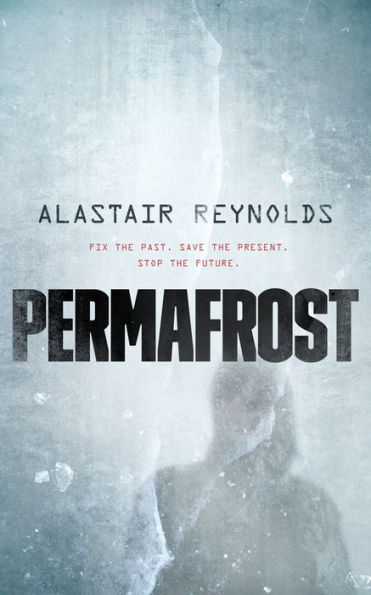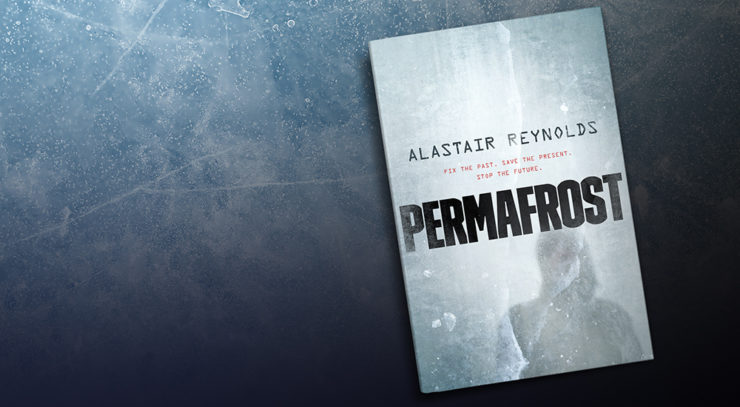How do you change history to stop an apocalypse, but without changing recorded history and suffering the severe consequences and chaos from doing so?
Time travel manipulation on a fine scale is a tightrope of a problem and the stakes are for the fate of the world. The world is dying. Time is running out for humanity, living on stored food that is running out. To save humanity, the Permafrost project seeks to use time travel to make a small change, a change that can bring hope to the future. But changing recorded history has enormous risks and challenges, the paradox can be ferocious and the consequences not entirely clear. And when it is clear that there is more than one agenda is brewing, that there might be other agents seeking different changes to history, the perils of changing the time stream might prove personally deadly.
These are the central questions and story at the heart of Alastair Reynolds time travel novella, Permafrost.
The heart of the novella is the mechanics of time travel, which Reynolds executes in detail, from theory and physical needs to implications and explications of what happens when things go wrong. This is the meticulous school of time travel narratives at work—how it works, what technology is used, what are the limitations, the possibilities, the risks, the hazards and what can and cannot be done in terms of changing history, and what happens when one tries. The novella has a scene centered on a paradox, and how the universe changes and resolves to take care of temporal inconsistencies. This feels like the beating heart of the novella, what the author is most interested in, and the novella rides high on the strength of it. Discussing the mechanics of the time travel itself is extremely difficult since its revelation and its implications are extremely central to the novella—for now, suffice it to say that the traveler sends their consciousness back in time, to inhabit the mind of another living being. I found the mechanism and the consequences of working out that mechanism to be a tour de force.
Above and beyond the clockwork beauty of the plotting and time travel technology, the other heart of the story is its protagonist, Valentina Lidova. An aging schoolteacher whose mother’s research was crucial as the seed of the theory that provided the Permafrost project to work, she is far from the usual protagonist for a story such as this. And that is why she is especially effective in this story, especially as there is a real contrast between Valentina and Tatiana, the woman in whom her mind inhabits in the past.
Buy the Book


Permafrost
The obvious parallels to make with this novella is with the TV series Travelers, but more to the literary side, Kate Heartfield’s pair of time travel novellas, Alice Payne Arrives and Alice Payne Rides, spring to mind. Those novellas are much more interested in the social relationships of the characters than Permafrost is. The Alice Payne novellas are also not interested at all in the mechanics of time travel and the ins and outs and its limitations. What those novellas do share with Permafrost is a strong interest in the consequences of time travel and changes to history. The theories of how that change occurs and what it does are radically different, and are a fascinating contrast in taking the same idea and working out implications in differing ways.
The world of Alice Payne is not in the absolutely apocalyptic state that Permafrost depicts, and so the novellas have more of an adventure feel to them. Permafrost has its apocalypse and troubles for Earth and humanity foregrounded, whereas Alice Payne has it instead backgrounded and not as serious—yet, anyway. I look forward to works like Max Gladstone and Amal El-Mohtar’s forthcoming This is How you Lose the Time War and how they tackle changes to history, multiple agents trying to change the timeline and how this all impacts on the characters.
For all that time travelers might seemingly have limitless time at first glance to execute their plans and operations, the thriller like pacing and the setup of Permafrost make it feel like the characters are always under the gun. It gives a strong page-turning feel to the book and I felt myself having to slow myself down to really consider the time travel mechanics rather than completely immersing myself in how fast a read it can be.
Permafrost is tightly executed and shows some of the possibilities and potentials of time travel and time changing narratives, showing that not one story can or does have a monopoly on exploring a subgenre of SF whose time has, apparently, come again.
Permafrost is available from Tor.com Publishing.
Read an excerpt from the novella here.
An ex-pat New Yorker living in Minnesota, Paul Weimer has been reading sci-fi and fantasy for over 30 years. An avid and enthusiastic amateur photographer, blogger and podcaster, Paul primarily contributes to the Skiffy and Fanty Show as blogger and podcaster, and the SFF Audio podcast. If you’ve spent any time reading about SFF online, you’ve probably read one of his blog comments or tweets (he’s @PrinceJvstin).










